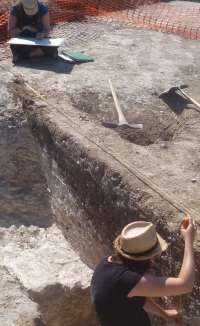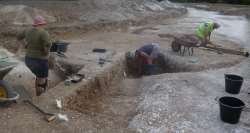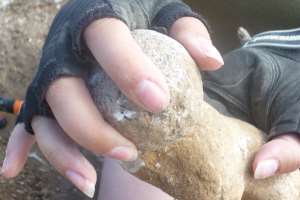
A hot day today, and no gas to boil the kettle in the morning, no tea, no good. Meanwhile work continues at a steady pace.

Segments 1 and 2 through the ring ditch are being drawn and recorded in detail. A plan of the feature on the east side of the second segment of the ring ditch suggests the feature may be almost rectangular in plan, and another small excavation is attempting to expose the southern corner to confirm the shape and hopefully reveal the stratigraphic relationship with the ring ditch. More about this feature as the excavation progresses tomorrow.
Segment 3, which appears to have been cut on the eastern side by another later feature, has reached a point where both edges of the cut for the ring ditch have been exposed. The sections of the excavation have been trimmed, nice and sharp for photographing and recording in the next couple of days to round of the excavation of the ditch.
For the first time it feels like we are beginning to understand the deep feature at the southern end of the ring ditch. In the record from 1982 it was suggested that the ditch had been cut away by two separate pits on the east and west sides, we can now see that these were part of a complex of pits whose fills have merged with that of a deep central feature.
We finally had to give up digging in the segment on the southern side of the feature as it became too deep to access within the confines of the narrow cut. We have traced the ridge of the upper egdes of the truncated ring ditch some distance into the pit complex, removing part of the fill of a segment excavated in 1982.

In this area we solved one of the problems thrown up by the preliminary magnetometer survey that we carried out on the site. A large anomaly showed up in an area covered by the trench, which indicated the presence of a major metal object in the ground. The anomaly coincided with the earlier segment excavated through the ditch. We discovered that the steel hinges of a door that was buried in the backfill were undoubtedly the cause of the response. Although it was a useful exercise in prospecting for the appropriate location for our excavation, the anomaly demonstrated the difficulty of re-excavating a site which has been disturbed by excavation in the past.

We have another interesting finds among the mixed pottery sherds we have been getting from the undisturbed areas of the ring ditch, all of which have quite wide date range form prehistoric to medieval. The round flint object is a hammer stone, or rubbing stone, formed by pecking a flint cobble around its whole surface until it forms a rough surfaced sphere. These spherical flint objects are common finds on Bronze Age and Iron Age sites in Thanet and may have been used as a form of pestle for grinding material against another flat stone, or possibly for rubbing and smoothing a hide that was being cured to make leather. It has also been suggested that they were used as a hammer in the process of knapping flint to form more delicate flake tools.
As we come to the last two days of our dig on Thursday and Friday, the final stages of excavating, recording and interpreting this important site will put the team under pressure, but we will make it! Keep following our journal entries for the final results over the next couple of days.